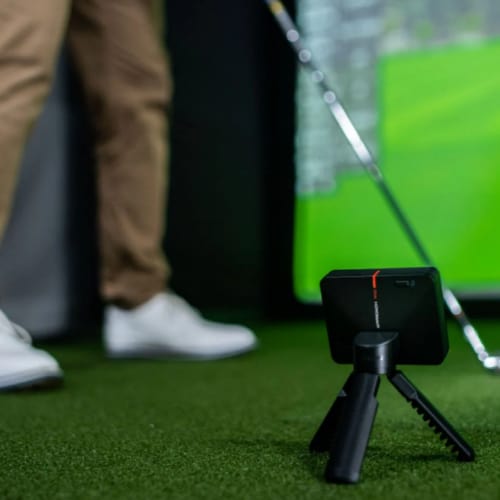Have you ever wondered if you can use launch monitors without hitting a ball? These devices typically require a golf ball to measure various aspects of your swing and ball flight.
However, some launch monitors now offer the ability to analyze your swing without the need for a physical ball. This innovative feature opens up new possibilities for practice and training, allowing you to work on your technique in settings where hitting balls may not be practical or permitted.
In this article, we’ll explore the concept of using launch monitors without a ball, discussing the advantages, limitations, and different types of devices available. We’ll also provide tips on how to set up and interpret the data from a launch monitor when used in this unique way.
The concept of using launch monitors without hitting a ball
Using a launch monitor without a ball involves taking swings with your clubs while the device tracks and analyzes your motion. The launch monitor captures data points such as club head speed, face angle, and swing path, providing valuable feedback on your swing mechanics.
Advantages of using launch monitors without a ball
One of the biggest advantages of using a launch monitor without a ball is the ability to practice indoors. You can work on your swing at home or the office without worrying about finding a suitable practice facility.
Moreover, hitting hundreds of golf balls at the driving range can be time-consuming and expensive. By using a launch monitor without a ball, you can save both time and money while still getting valuable feedback on your swing.
Check Also: Are Launch Monitors Accurate with Range Balls?
Also, when you remove the ball from the equation, you can focus solely on your swing mechanics. This allows you to make adjustments and experiment with different techniques without the distraction of ball flight.
Disadvantages of using launch monitors without a ball
While using a launch monitor without a ball provides valuable data on your swing, it doesn’t offer the same real-world feedback as hitting an actual golf ball. You miss out on seeing how your swing translates to ball flight, which is crucial for understanding your game.
Without the feedback of ball flight, there’s also a risk of developing bad habits in your swing. You might make adjustments that feel good but don’t necessarily translate to improved performance on the course.
Interpreting Data from a Launch Monitor Used Without a Ball

When using a launch monitor without a ball, it’s crucial to understand how to interpret the data provided by the device. It’s important to focus on the right metrics and recognize the limitations of this method. Focus on the following data points:
Club head speed
Club head speed is one of the most important factors in determining ball speed and distance. When using a launch monitor without a ball, pay close attention to your club head speed numbers to ensure you’re generating optimal velocity through impact.
Face angle at impact
The angle of the club face at impact plays a significant role in determining ball flight direction and spin. By monitoring your face angle data when practicing without a ball, you can work on squaring the club face consistently and minimizing unwanted curvature in your shots.
Club path
Club path refers to the direction the club head is traveling in relation to the target line at impact. This metric influences the initial starting direction of the ball and can contribute to hooks, slices or straight shots. Analyzing your club path data can help you identify and correct swing flaws that may be affecting your shot shape.
Angle of attack
Angle of attack is the angle at which the club head approaches the ball at impact, relative to the ground. This metric can affect launch angle, spin rate and overall ball flight. When practicing without a ball, pay attention to your angle of attack numbers to ensure you’re creating the optimal launch conditions for your desired shot shape and trajectory.
Comparing data to real-world shots
While practicing with a launch monitor without a ball can provide valuable data, it’s essential to recognize the limitations of this method. Without the ball’s interaction with the club face, certain metrics like ball speed, launch angle and spin rate cannot be accurately measured. As a result, the data you receive may not fully represent the actual flight characteristics of your shots.
However, despite these limitations, the data obtained from practicing without a ball can still serve as a useful guide for improving your swing mechanics. By focusing on key metrics like club head speed, face angle, club path, and angle of attack, you can identify areas of your swing that need attention and work on making the necessary adjustments.
To get the most out of your practice sessions, combine the insights gained from using a launch monitor without a ball with real-world feedback from hitting balls on the range or course. This holistic approach will help you develop a more complete understanding of your game and make meaningful improvements to your technique.
Drills and Exercises to Perform with a Launch Monitor Without a Ball

Using a launch monitor without a ball provides a unique opportunity to focus on specific aspects of your swing and make targeted improvements. By incorporating drills and exercises that emphasize tempo, timing, club face control, and swing plane, you can optimize your practice sessions and see measurable progress in your game.
Tempo and Timing Drills
Here are some drills that can improve on your tempo and timing:
Pause drill
The pause drill helps you develop a smooth, rhythmic swing by introducing a brief pause at the top of your backswing. To perform this drill:
- Set up your launch monitor and take your normal stance.
- Begin your backswing, and when you reach the top, pause for a count of two.
- Initiate your downswing, maintaining a smooth tempo throughout.
- Repeat this process, focusing on creating a consistent rhythm and tempo.
Continuous motion drill
The continuous motion drill promotes a fluid, uninterrupted swing from start to finish. To execute this drill:
- Begin your backswing, focusing on a smooth, continuous motion.
- Transition seamlessly into your downswing, maintaining the same fluid movement.
- Repeat the drill, emphasizing a continuous, uninterrupted swing.
Club Face Control Drills
Practice the following drills if you need to work on your club face control:
Face-to-path drill

The face-to-path drill helps you develop a better understanding of how your club face position relates to your swing path. To perform this drill, start by taking your normal stance.
After that, focus on aligning your club face with your intended swing path. Make a swing, paying attention to the relationship between your club face and swing path, and then use the feedback from your launch monitor to make adjustments and improve your face-to-path alignment.
Face-to-target drill
The face-to-target drill emphasizes the importance of squaring your club face to your target at impact.
- Align your clubface directly with your intended target.
- Make a swing while focusing on maintaining a square club face at impact.
- Use the tracked data to refine your technique and improve your ability to square the club face consistently.
Swing plane and path drills
For swing plane and path, we suggest these two drills:
Inside-to-inside drill
The inside-to-inside drill helps you develop a more efficient swing plane and path.
- Focus on taking the club back on an inside path, relative to your target line.
- Transition to your downswing, maintaining an inside path through impact.
- Repeat this process, using your launch monitor data to refine your swing plane and path.
Around-the-body drill
The around-the-body drill promotes a connected, rotational swing that relies on proper body rotation. To execute this drill, initiate your backswing, focusing on turning your shoulders and hips in a synchronized manner. Then, transition to your downswing, maintaining a connected, rotational motion around your body.
The feedback from your launch monitor should help you improve your body rotation and overall swing sequence.
Frequently Asked Questions
The following are answers to some commonly asked questions concerning the use of golf launch monitors without balls. These will help you better understand this unconventional way of practice.
Can all launch monitors be used without a ball?
Not all launch monitors can be used without a ball. Some, particularly those that rely on radar technology, require a ball to be hit to track and measure data. However, many modern launch monitors, such as those that use camera-based or hybrid technology, offer the option to practice and analyze swings without the need for a physical ball.
How accurate are launch monitors when used without a ball?
The accuracy of launch monitors, when used without a ball, can vary depending on the specific device and technology employed. Generally, high-end launch monitors that utilize advanced camera systems or hybrid technology tend to provide more accurate data when used in a ball-free setting.
However, it’s important to note that the absence of a ball may result in some limitations when it comes to evaluating certain aspects of your shot, such as ball flight and spin rates.
Can using a launch monitor without a ball improve my golf swing?
Yes, practicing with a launch monitor without a ball can be an effective way to improve your swing. By focusing on specific aspects of your swing, such as tempo, timing, club face control, and swing plane, you can make targeted improvements to your technique.
However, it’s important to remember that practicing without a ball should be used in conjunction with regular practice sessions that involve hitting balls to ensure a well-rounded approach to your game improvement.
Are there any safety concerns when using a launch monitor without a ball?
Using a launch monitor without a ball is generally considered safe, as there is no risk of being struck by a moving golf ball. However, it’s still important to follow the manufacturer’s guidelines and exercise caution when setting up and using the device.
Ensure that you have adequate space to swing your clubs freely and that the launch monitor is properly positioned and secured to prevent any accidents or damage to the equipment.
How often should I use a launch monitor without a ball in my practice routine?
Some golfers may find it beneficial to use a launch monitor without a ball for a short session every day, focusing on specific drills or swing mechanics. Others may prefer to dedicate longer sessions a few times a week to analyze their swing data and make adjustments.
Ultimately, the key is to find a balance that works for you and to use the launch monitor as a complementary tool alongside regular practice sessions with a ball to maximize your improvement and enjoyment of the game.
Final Thoughts
Using a launch monitor without a ball can be useful for golfers looking to improve their swing mechanics and optimize their practice sessions. While this method offers benefits such as indoor practice, time and cost savings and a focus on specific swing aspects, it’s essential to acknowledge its limitations, including the lack of real-world feedback.
Even though launch monitors provide valuable data on swing mechanics without a ball, it’s recommended to complement this method with regular practice hitting actual balls. This allows you to see how the mechanics you’re developing translate to real-world ball flight and performance. To learn more before choosing a launch monitor that best suits your needs, check out our comprehensive review of the leading golf launch monitors available on the market.
If you have any questions or comments, please contact us.




